Welcome to the final post of the 100 Years of Yuri 2020 Project! With this post, the first centennial anniversary of the Yuri genre is complete. We can walk forward into a new century, assured in the knowledge that we have absolutely no idea at all what will happen. ^_^
One of the most often-asked questions I get is “where do I start?” when it comes to reading and watching Yuri. My criteria for this list was simple: Answer that question using primarily English-language releases (as the readership for Okazu is primarily, although not exclusively, English readers.) This list is an attempt to trace the evolution of the Yuri genre over 100 years. These choices will help you understand where the tropes of our genre came from and how they developed. The series mentioned here had massive influence on our perception of Yuri. There are still a few critical pieces that are not yet available in English – I hope that one day I’ll be able to say they are. In the meantime, I’ve added them in in Japanese, for those of you who are dedicated to learning more about the origins of the genre.
I’m presenting these choices in chronological order, from earliest to most recent. Here are my recommendations to understand 100 years of of the Yuri genre.
Titles have been edited so series available in English use official English-language titles, and Japanese-only titles are in Romaji (with Kanji in parentheses).
 Yaneura no Nishojo (屋根裏の二処女) by Yoshiya Nobuko
Yaneura no Nishojo (屋根裏の二処女) by Yoshiya Nobuko
Yoshiya Nobuko’s story about two girls living in the attic room of a foreign-run mission school is the origin for so many of the tropes we have come to expect from Yuri – from the tower room itself, to an intimate piano duet.
Akiko, who take three pages to open a door when we meet her, does not hesitate to take Akitsu’s hand and go to the outside world, together, a choice echoed by two women who lived in a tower almost a century later in Revolutionary Girl Utena.
We would not speak of or think of Yuri in the way we do now, if it weren’t for this foundational work, Yaneura no Nishojo.
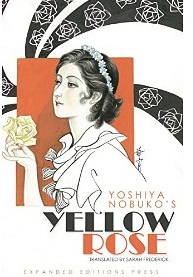 Yellow Rose by Yoshiya Nobuko
Yellow Rose by Yoshiya Nobuko
In the first part of the 20th century, as the “S” aesthetic was sweeping Japan and creating a culture for girls, Yoshiya Nobuko’s serialized short stories of the lives of young women were wildly popular. Hana Monogatari represented girls’ lives as they moved out of school into adult life. The protagonists of these stories often embraced new technologies so instead of marrying, they lived independent lives as working women.
Yellow Rose is the only one of these stories available in English. Translated by Dr. Sarah Frederick, published digitally by Expanded Editions, this short, but intense, story captures the feel of classic Japanese literature and the sense of the dawning of a completely modern age. Trains and typewriters loom as large as Sappho and her poetry in this fascinating, darkly emotional tale about unexpected feelings of attraction and loss. This is an excellent place to start with in your English-language journey through Yuri.
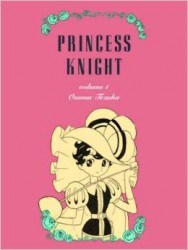 Princess Knight by Osamu Tezuka
Princess Knight by Osamu Tezuka
The Yuri trope of the Girl Prince has roots going back to the Heian period, but as far as manga is concerned, this is where it began. Tezuka, known as the “god of manga.” captured the glamour of the all-woman musical revue named for the town he lived in, Takarazuka, added a bit of Disney flair, spiced it up with a little gender-bending to create Ribon no Kishi, Princess Knight (Volume 1 | Volume 2) available from Vertical Publishing. This book is technically out of print. Consult your local library to get it by Interlibrary Loan.
Sapphire is born to be the Prince of her country except that, as a girl, she can’t rule. But because she has the heart of a man and a woman, and to stave off the evil Duke, Sapphire grows up acting as the Prince. Her boy heart give her athletic and ruling abilities, but her girl heart makes her yearn for love and beautiful gowns. This story relies on mid-century gender stereotypes, but it is the origin of a theme we will see over and over again in Yuri; the blending of male and female in a noble Girl Prince.
 Shiroi Heya no Futari (白い部屋のふたり) by Yamagishi Ryoko
Shiroi Heya no Futari (白い部屋のふたり) by Yamagishi Ryoko
There’s always controversy around the “first” anything, but if there is a single manga that has claim to being the first truly “Yuri” manga, Yamagishi Ryoko’s Shiroi Heya no Futari is the leading candidate. It codified Yuri tropes visually, in the same way Yoshiya’s novel Yaneura no Nishojo did thematically.
Emotionally high-strung traditional Japanese beauty Simone and cheerful and European doll-like Resine meet in a foreign mission school. Both of them outsiders to the school, they share an attic room where they fall in love. But there can be no happy ending for them, so Simone runs off to die a tragic death (one that immediately recalls American lesbian pulp novels of the time) to “free” Resine to marry.
Almost 50 years later, we still see the ripples of Simone and Resine in other popular Yuri series about a romance between an emotionally unbalanced dark-haired beauty and a cheerful girl, most recently saburouta’s Citrus. Shiroi Heya no Futari is long out of print and not available in English, but I hope one day to be able say that this classic Yuri manga is heading our way, if only to share the “original” Yuri manga with you.
 The Rose of Versailles by Riyoko Ikeda
The Rose of Versailles by Riyoko Ikeda
Sometimes it is easy to look back and see why a thing sparked the zeitgeist. Timeless tales told with high drama, history as seen through a modern lens; the human drama of human drama is always popular.
The French Revolution is so enormous that it may be best told as one person’s story. Whether we follow Jean Valjean or Oscar François de Jarjayes, seeing the events from one perspective gives us a place to start as the grand and ghastly true tale unfolds. With such epic historical content, Riyoko Ikeda still manages to make The Rose of Versailles relatable. Oscar stands atop the pinnacle of the Girl Prince trope and we, the readers, understand perfectly why the men and women who knew her, loved her. Tezuka may have created the Girl Prince, but Ikeda perfected her.
Now that there is a definitive English edition of The Rose of Versailles manga from UDON Entertainment, we can one day hope for a definitive edition of another of Ikeda’s masterworks, Dear Brother (Oniisama e).
 Pretty Guardian Sailor Moon by Naoko Takeuchi
Pretty Guardian Sailor Moon by Naoko Takeuchi
In any modern series we’d be happy to see a lesbian couple form an alternative family with three mothers and a daughter. In any current series, we’d be delighted to see a team of women willing to die to save one another. More than 25 years ago we got all that, and more. Pretty Guardian Sailor Moon as a series includes multiple instances of sexual and gender minority characters. In a series ostensibly for children. Not all of them are dead at the end of the series. For a 25-year old series, that seems a miracle.
Miracle or not, it is one more reason to continue to love a magical girl series that has inspired-and still inspires – a quarter of century of creativity, of social expression and a ridiculous number of Yuri artists and writers. With both anime from Viz Media and manga from Kodansha Comics available in English, it’s time to fall in love with the Senshi – and watch Haruka and Michiru, the queens of Yuri, fall in love with each other – all over again.
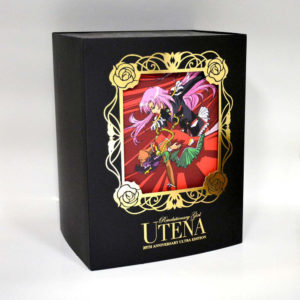 Revolutionary Girl Utena by BePapas
Revolutionary Girl Utena by BePapas
On the cusp of a new millennium, a group of extraordinarily talented anime and manga creators teamed up. They took Yuri tropes, magical girl tropes, festooned them with dueling and overtly meaningless symbols that were left to grow in a fertile petrie dish of adolescent awakening until they developed meaning. They covered it with the musical equivalent of a magical cookbook full of spells and paid homage to dozens of Yuri predecessors in the anime, movie and manga series that followed. Revolutionary Girl Utena was indeed revolutionary to the fans who watched wide-eyed as Utena unsheathed Dios’ sword from Anthy’s chest and were lead into the birth of a whole new genre.
Revolutionary Girl Utena gave us Utena and Anthy, but it also gave us Juri, the lesbian whose heart is locked up in her love for a manipulative (and, depending upon who you ask, unworthy) Shiori. It gave us a whole new set of Yuri archetypes, explored all the old archetypes with fresh eyes and ushered in a massive wave of fans, ready for a new genre. In many ways, Yuri could not have been born without the magical unrealism of Utena. Both anime, movie from RightStuf and manga and movie manga from Viz Media have received definitive releases in English, so it’s worth taking a look at all four of the stories to see all of the alternative versions of this important series.
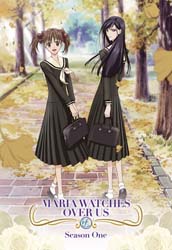 Maria Watches Over Us by Oyuki Konno
Maria Watches Over Us by Oyuki Konno
At the same time Utena was redefining and reimagining magical girl Yuri, another series was doing the same with the early 20th century “S” aesthetic. Maria-sama ga Miteru was developed by Konno Oyuki as a 39-novel series (plus 9 other related novels) over 15 years. It was adapted into 4 seasons of anime, an 8-voume manga series, and at least 26 different Drama CDs.
Fukuzawa Yumi is honest and goodhearted, but not, apparently, special. We watch this “average” girl become involved with – but not overwhelmed by – the elites of the school, the Student Council and most especially, with the object of her own admiration, Ogasawara Sachiko. The focus of the series is on the big sister/little sister relationship trope that was so deeply embedded in Yuri and so well-known to Japanese fans, but mostly unknown to western audiences, as none of the early sources had been (and many remain) untranslated. When Maria Watches Over Us, available in English from Sentai, debuted as an anime, an entire generation of global Yuri fans learned about the specific and sisterly bonds between girls that had been encouraged since Akiko and Akitsu shared that tower room in the early part of the 20th century.
 ALC Publishing
ALC Publishing
In 2003, ALC Publishing published the very first “Yuri manga” in English, Rica ‘tte Kanji!?, which went for 3 printings. Further chapters were serialized in in ALC’s Yuri Monogatari anthology until it was collected and reprinted digitally in 2012 as Tokyo Love – Rica ‘tte Kanji! Digital Collection. Rica was followed by Tadeno Eriko’s doujinshi collection WORKS, which is still in print and the Yuri Monogatari series, of which Volume 4 and Volume 6 are still in print.
The Yuri Monogatari anthology series (named in homage to Yoshiya Nobuko’s Hana Monogatari,) brought together Yuri artists from around the world in the very first English-language Yuri anthology. The goal was to present English-language readers with a wide variety of story and art and encourage them to look beyond girl-meets-girl.
ALC Publishing laid the English language foundation for the western Yuri market, with a strong emphasis on stories of adult lesbian life, rather than the still more common first-love school scenarios.
 Cutey Honey & Devilman Lady by Go Nagai
Cutey Honey & Devilman Lady by Go Nagai
If Osamu Tezuka is the “God of Manga” then Go Nagai is manga’s brilliant, but creepy uncle. Every genre that Tezuka established, Nagai did too, weirder and, arguably, better. Nagai is known in the west primarily for his Devilman and Mazinger franchises. In Cute Honey, Nagai created a magical female warrior who did not need men to help her (and often had to save them from harm) and a lesbian love story that has evolved and survived over decades. The Cutey Honey Classic Collection manga from Seven Seas and Cutey Honey Universe anime from Sentai Filmworks are exceptional versions of this timeless, yet pervy, story.
But where Nagai really excels is in the horror genre. He was born to create and explore the dark underbelly of demonic existence. The 2018 Netflix release of Devilman Crybaby was deeply queer and absolutely worth watching as a horror series. As far as Yuri goes, the series we should all know is Devilman Lady, released in the 2000s by ADV (now, by Section 23) as Devil Lady. Hopefully we’ll see a 20th anniversary release of one of the objectively best Yuri anime ever made just as lesbian horror is undergoing a long-awaited renaissance.
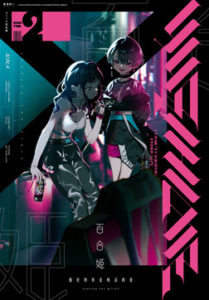 Comic Yuri Hime (コミック百合姫)
Comic Yuri Hime (コミック百合姫)
The story of Comic Yuri Hime is the story of Yuri at the turn of the 21st century. This magazine burst forth in 2003 as Yuri Shimai and the last 2 decades have seen repeated renewals and rebirths as the market shifts and changes.
Beginning life as a quarterly magazine, Comic Yuri Hime is now monthly and has been home to the growth of many of the top name sellers in Yuri manga, from Morinaga Milk to Kodama Naoko. Along with the careers of their creators, these pages have seen so many of the newest iterations of old Yuri standards and, with folks like Ohi Pikachi and Takemiya Jin, its even broken some new ground.
While there is no English-language version, you can subscribe to it digitally in Japanese on Bookwalker Global.
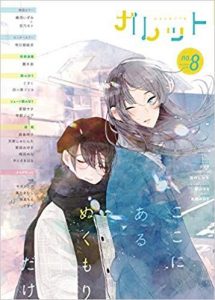 Galette (ガレット)
Galette (ガレット)
I think of Comic Yuri Hime as a pathway that has been paved and widened over time and is now a highway for Yuri artists to take from their own work to published status. Using that metaphor, Galette magazine is an upgrade to the old road that parallels the new expressway. It’s still a smaller road, but there are a lot of things to look at, and accommodations are often more interesting/quirky than they are on the highway.
This crowd-funded, creator owned quarterly Yuri manga magazine is giving complete freedom to Yuri creators. We have no idea what we’ll see along the way, but it will surely be interesting!
Galette is also available for Japanese-language subscription through Bookwalker Global.
 Kase-san Series by Hiromi Takashima
Kase-san Series by Hiromi Takashima
Hiromi Takashima’s Kase-san series is a story of survival and tenacity. It was born in a brief period of prosperity during a Yuri boom in 2011. When the magazine it ran in went belly up, it would have been reasonable to assume we’d never see more of it after the third volume was published. But the creator didn’t agree and took her work online and continued the story. Without a magazine for an anchor, its amazing that this series was given a fourth volume, then a fifth. And then an actual miracle occurred. Because while the Kase-san series was continuing, peripatetic although it was, the Yuri market had blossomed since 2014. In 2017, the world was ready for Kase-san and Yamada to leave school and not live happily ever after, but continue on dealing with things like jealousy and separation and two lives moving in different directions as adults.
The manga series is available from Seven Seas and the beautifully animated OVA is available from Sentai Filmworks. The Kase-san series both embodies common Yuri tropes and exceeds them, which makes it an important stepping stone to understanding Yuri.
 My Lesbian Experience With Loneliness by Kabi Nagata
My Lesbian Experience With Loneliness by Kabi Nagata
One day, there will be articles and research about the impact this book, its sequels and its creator had on manga. Japanese manga has already seen an uptick in manga about mental and physical health. I don’t think I can overstate how important this book will be as we move forward in the 2020s.
Autobiographical comics are not uncommon in the west or Japan. When we look back at some of the greatest western comic artists, their stories about their own lives have resonated deeply with millions of readers. For a Japanese manga to join the ranks of Harvey Pekar, Alison Bechdel and Raina Telgemeier among our comics awards, is notable. In the sense that this is not “Yuri” at all, but is by and about life of a queer person, it threw doors wide open.
Kabi Nagata has already been recognized for her work with a Harvey Award. The creator being open about being gay, without any sense that story this is – or ever can be – a romance story, has already had a massive impact and I expect we will see ripples for years to come.
My Lesbian Experience With Loneliness and My Solo Exchange Diary Volume 1 and Volume 2 are available in English from Seven Seas.
 Yuri Life by Kurukuruhime
Yuri Life by Kurukuruhime
The last few years has seen the creation of a brand new subgenre of Yuri. Known in Japanese as Shakaijin Yuri (社会人百合), these stories follow adult women in society. Often written as office romances, they allow for exploration of life as an adult woman in the working world, a place that is often a hostile environment for women.
Kurukuruhime’s Yuri Life avoids the problems and instead focuses on pairs of adult women making their lives together.
Adult life Yuri is not new – ALC Publishing’s WORKS addresses many of the same issues we see addressed in stories like Still Sick from Viz Media but Yuri Life and Whenever Our Eyes Meet, both from Yen Press are the first two adult life Yuri to make it into English and are notable for being the opening adult women needed to be part of the Yuri landscape.
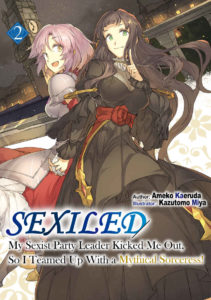 Sexiled: My Sexist Party Leader Kicked Me Out, So I Teamed Up With a Mythical Sorceress! by Ameco Kaeruda
Sexiled: My Sexist Party Leader Kicked Me Out, So I Teamed Up With a Mythical Sorceress! by Ameco Kaeruda
The end of our first Yuri century just about exploded with whole new sections of the Yuri genre. Visual novels, office life Yuri, and Light Novels all carpet bombed Yuri fandom. I waffled heavily trying to pick just one truly representative Light Novel. Bloom Into You: Regarding Saeki Sayaka from Seven Seas was certainly representative of the older schoolgirl romance tropes and it was still a very good light novel, but the example I chose for this list was the one that broke new ground.
We might have expected it from a office romance, (and, admittedly, we see examples of the frustration with systemic misogyny in almost every example of that subgenre) but for pure, unadulterated exhaustion with misogyny, with a sense of being so far over it, that it’s unbelievable it still exists at all and with the kind of empowerment women can give one another when they work together in a Yuri story, I had to go with Ameco Kaeruda’s RPG Fantasy Sexiled: My Sexist Party Leader Kicked Me Out, So I Teamed Up With a Mythical Sorceress! Volume1 and Volume 2 are available digitally and Volume 1 will be released in print in 2020 from J-Novel Club.
 Our Dreams at Dusk Shimanami Tasogare
Our Dreams at Dusk Shimanami Tasogare
Following on the heels of openly queer creators whose work is breaking sales records and breaking new ground at the same time, Kamatani Yuhki-sensei took the next step forward with a manga about sexual and gender minorities and the community they create for themselves. Like Rica ‘tte Kanji?!, Our Dreams at Dusk Shimanami Tasogare from Seven Seas uses the life of one young person, still questioning themselves to learn about the ups and downs of other people’s lives – all with eye to creating empathy and acceptance.
At the end of a century of Yuri, we are finally seeing what I always hoped we’d see – lesbian stories, stories of lives led, and loves found and lost. Yuri is still undergoing a massive change as more stories of adult life move into the Yuri genre. Eventually, as Yuri creators age, I have no doubt we’ll see senior years romance and life. ^_^
And here you have – it a primer for 100 Years of Yuri. With these titles, you will encounter all of the traditional Yuri tropes, where they came from and be able to see where they creators are taking them.
2020 is going to bring us absolute riches of both classic and new Yuri. With all these riches, I want to point out – again – that I’m still not seeing a few things that I want to see. So as we move into 2CYE (Common Yuri Era), here is my wish list for Yuri:
- Sports Yuri manga series
- “Ladies” Motorcycle gang Yuri series
- High-powered Court Yuri Lawyer drama
- Mystery-solving Lesbian Detective series
- Space Marine Yuri Science Fiction
- Senior Yuri Romance
…and, borrowed whole from petrarchian on Twitter:
- A mezzo and a soprano who fall in love during a run of Der Rosenkavalier Opera Yuri ^_^
There’s my wish list – have at it, Yuri creators!
Thank you all for reading our lists, contributing your thoughts and here’s to a brilliant decade for Yuri!
![]() Today I wanted to review something that made me happy. And, for several reasons, this book was just the ticket. Ohsawa Yayoi’s Hello, Melancholic!, Volume 1 (ハロー、メランコリック! ) is an emotional rollercoaster with a sound track. ^_^
Today I wanted to review something that made me happy. And, for several reasons, this book was just the ticket. Ohsawa Yayoi’s Hello, Melancholic!, Volume 1 (ハロー、メランコリック! ) is an emotional rollercoaster with a sound track. ^_^

